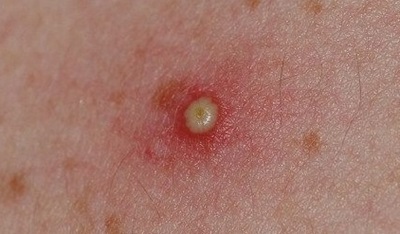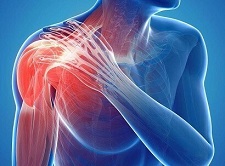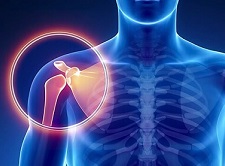- Home
- Common Shoulder Problems
- Shoulder Cysts
Cyst On Shoulder
Written By: Chloe Wilson BSc (Hons) Physiotherapy
Reviewed By: SPE Medical Review Board

A cyst on the shoulder is a common problem often causing a lump on the shoulder.
Most shoulder cysts are completely harmless and they often don’t cause any problems and may go completely unnoticed.
But in some cases, they can cause pain, weakness or restrict arm movements, particularly when they are associated with other shoulder problems.
A cyst on the shoulder is typically a small pocket of fluid that has collected in or near the shoulder joint. Shoulder injuries, degeneration, muscle imbalance and underlying problem can cause excess fluid to pool and form a sac. Cysts are a common cause of shoulder lumps.
There are lots of treatment options for a cyst on the shoulder but if there is no pain or restriction, you can usually just keep a gentle watch and might not ever need any treatment.
Here we will look at the different types of shoulder cysts, why they form, common causes and symptoms and the best treatment options.
What Is A Shoulder Cyst?
A shoulder cyst is a small pocket or sac of tissue, typically filled with fluid.
Cysts can occur anywhere around the shoulder and are usually due to an injury, degeneration, infection, rotator cuff tears, aging or other medical issue that causes the shoulder to produce excess synovial fluid.
Shoulder cysts are extremely common but often go unnoticed and they don’t always cause any symptoms. In fact, studies have found that between 15-45% of the population with no shoulder pain have cysts in their shoulder.
There are a number of different types of cyst on shoulder that can form for various different reasons:
1. Labral Cyst Shoulder

The most common type of cyst on the shoulder is a Labral Shoulder Cyst.
These pockets of swelling, also known as paralabral shoulder cysts, are caused by a tear in the shoulder labrum - the ring of cartilage that runs around the rim of the shoulder socket to improve joint stability.
Shoulder labral cysts can develop anywhere around the labrum depending on the location of the tear:
- SLAP Tears: tear in the upper part of the labrum
- Bankart Lesion: tear in lower part of labrum and
- Posterior Labrum Tear: tear at the back of the shoulder socket
Shoulder labrum tears are usually caused by trauma e.g. a fall onto an outstretched arm, shoulder dislocation or contact injury in sport, repetitive friction e.g. lots of overhead activities such as racket sports or construction work or degeneration e.g. aging or arthritis.
A labral cyst doesn’t usually cause pain itself, but there are often symptoms from the labrum tear including pain, weakness, instability and clicking/catching sensations when moving the arm.
You can find out more about paralabral cysts on shoulder in the Shoulder Labrum Tear section.
2. Ganglion Cyst Shoulder

Ganglion Cysts are another common type of cyst on the shoulder that can develop anywhere.
Ganglion cysts are small fluid-filled sacs that forms just underneath the skin near joints or tendons. Shoulder ganglion cysts are filled with thick, jelly-like synovial fluid that balloon out from a tendon sheath or joint.
Anything which causes the body to produce excess synovial fluid e.g. trauma, repetitive stress or joint degeneration, can result in the fluid leaking out of the joint/tendon through a tunnel type stalk, where it collects and forms a fluid-filled sac.
Ganglion cysts vary in size from around 0.5cm to 4cm wide and they often fluctuate in size. A ganglion cyst on the shoulder doesn’t typically cause any symptoms, unless it starts to compress one of the nearby nerves. If that happens, there may be nerve pain, weakness, tingling and numbness from the cyst on the shoulder that may extend down the arm towards the elbow and hand.
Ganglion cysts of the shoulder may form in isolation or there may be a group of cysts connected by a common stalk.
3. Subcortical Cyst Shoulder
Subcortical shoulder cysts are found just beneath the outer layer of bone, known as the cortical bone.
They are typically associated with aging, shoulder impingement and rotator cuff tears, particularly when the tendon tears away from where it attaches directly to the bone. This releases synovial fluid that irritates the bone causing inflammation and cyst formation.
Subcortical shoulder cysts are often asymptomatic i.e. don’t cause any symptoms.
4. Subchondral Cyst Shoulder
Subchondral bone cysts are found in the subchondral bone – the layer of bone that sits just beneath the joint’s cartilage surface. These shoulder cysts may form either due to abnormal stress on bony surfaces in a degenerative joint causing focal bone necrosis (death) or due to synovial fluid infiltrating the bone through damaged cartilage.
Subchondral shoulder cysts are usually asymptomatic. While both subcortical and subchondral cysts involve fluid-filled sacs in bone tissue, the key distinction lies in their specific locations within the joint—subchondral cysts are beneath the joint's cartilage, and subcortical cysts are beneath the outer layer of bone.
5. Sebaceous Cyst On Shoulder
A sebaceous cyst on the shoulder, aka epidermoid shoulder cyst is a small sac filled with keratin, a fibrous protein that helps form the skins out layer. They can develop anywhere around the shoulder but are the most common type of cyst on back of shoulder.
Epidermoid shoulder cysts are usually slow-growing and can range in size from a few millimetres to a few inches in diameter. A sebaceous cyst on the shoulder is usually completely harmless and doesn’t require treatment. In some cases, the cheesy-white thick fluid may need to be drained.
6. Folliculitis

Folliculitis develops when there is inflammation and infection of hair follicles, usually from friction, which cause small cysts to form.
There are often a number of lumps at the same time with folliculitis and they may be itchy.
Folliculitis cysts on the shoulder usually need to be treated with a course of antibiotics, they don't tend to go away on their own.
Cyst On Shoulder Causes
Common causes of shoulder cysts include:
- Rotator Cuff Tears: likely due to the inflammatory reaction causing increased synovial fluid production which collects and forms a shoulder cyst
- Previous Surgery: cysts can form following shoulder surgery, particularly rotator cuff repairs where small holes have been drilled into the bone for suture anchors so the tendon can be sewn back into place on the bone. In some case synovial fluid seeps out of the anchor points forming a cyst on the shoulder known as a perianchor cyst. They don’t usually cause any pain and don’t increase the risk of rotator cuff re-tearing or shoulder instability.
- Infection: e.g. abscesses are usually accompanied by pain, swelling and fever. Infected shoulder cysts are usually treated with antibiotics and may need to be drained surgically
- Degenerative Disease: e.g. osteoarthritis, rheumatoid arthritis and avascular necrosis can lead to excess synovial production in the joint
- Muscle Imbalance: weakness and tightness in the shoulder muscles can lead to increased pressure and friction on different parts of the shoulder, and that irritation may result in the formation of a shoulder cyst
Shoulder Cyst Diagnosis
A cyst on the shoulder is usually diagnosed by a combination of medical review, physical examination and imaging tests. You doctor will start by ask you about your symptoms, lifestyle and typical activities and any previous injuries or medical conditions.

They will then examine your shoulder, looking at the position, shape, size and feel of the cyst on your shoulder, and get you to perform various movements to assess the range of motion and strength in your shoulder.
Your doctor may also send you for imaging tests, usually an ultrasound or MRI scan to assess the shoulder further. This helps to identify the type of cyst and any underlying causes that may have caused it to form e.g. labrum tear or rotator cuff damage.
#CommissionsEarned from Amazon on qualifying purchases
Shoulder Cyst Treatment
Treatment for a cyst on the shoulder is usually non-surgical, and if there are no associated symptoms, your doctor may advise a watch and wait approach. If you are getting symptoms, common treatment for a cyst on the shoulder includes:
- Rest: from aggravating activities e.g. avoiding any overhead arm activities, to help reduce synovial fluid production around the cyst
- Ice: regularly applying a shoulder ice pack to the affected area can help to reduce pain and excess fluid production in the shoulder
- Medications: over-the-counter medications such as pain relievers e.g. paracetamol/acetaminophen or anti-inflammatories e.g. ibuprofen/Advil can help to reduce pain and inflammation associated with a cyst on the shoulder and any underlying shoulder problems
- Aspiration: involves draining the fluid from the shoulder cyst with a needle. Aspiration is only indicated if the cyst on shoulder is causing pain or limiting arm movements. There is a high recurrence rate of shoulder cysts after aspiration so it is important to address the underlying cause
- Corticosteroid Injections: Your doctor may recommend injecting your shoulder cyst with a mixture of corticosteroid and local anesthetic to reduce inflammation and pain. Steroid injections for shoulder cysts are often done in conjunction with aspiration
- Exercises: A combination of strengthening, stretching and stability exercises can help to improve shoulder strength and range of motion. Not only can exercises help to reduce the symptoms associated with a shoulder cyst but they can also address any underlying joint issues or soft tissue damage. For example, rotator cuff strengthening exercises and scapular stabilization exercises can be helpful for improving strength and stability at the shoulder which can help reduce the risk of shoulder injuries and cyst formation
Shoulder Cyst Removal Surgery
If non-surgical treatment measures are ineffective or if the cyst persists, surgical removal of the cyst on the shoulder may be recommended. Shoulder cyst removal surgery is typically reserved for cases where the cyst is causing significant pain or functional impairment.
Shoulder cyst removal surgery may be carried out
- Arthroscopically: keyhole surgery. Small incisions are made and a miniature camera, known as an arthroscope, is inserted into the shoulder so the surgeon can see the inside of the joint. The surgeon inserts special surgical instruments in through the incisions to cut and remove the cyst.
- Open Surgery: a medium size incision, usually around 2 inches long, is made directly over the affected area and the cyst is removed
In both cases, if there is any other associated damage, e.g. labral tear or rotator cuff tear, they will be repaired at the same time.
Other Causes Of Lumps On Shoulder
Cysts are one of the most common causes of lumps on the shoulder but there are other possible causes too:
- Lipoma: soft lump of fatty tissue that forms just under the skin
- Muscle Knot: small, hard lump caused by spasming, tension or tearing in the muscle fibres. Particularly common in the trapezius muscle between the shoulder blade and spine
- Bursitis: inflammation of one of the fluid-filled sacs that sit between the shoulder tendons and bones to reduce friction. There are a number of bursa located around the shoulder and any of them can get inflamed.
- Keratosis Pilaris: large clusters of small, white or red bumps that typically form on the upper arm
- Calcific Tendonitis: not technically a cyst but causes cyst-like changes. Calcium deposits form in and around tendons due to trauma, hypoxia and metabolic derangement
Cyst On Shoulder Summary
Shoulder cysts are very common and often cause minimal symptoms.
In most cases a cyst on the shoulder is due to an underlying problem such as a rotator cuff tear, labrum tear, arthritis or previous shoulder injuries.
The most common types of cyst on shoulder are labral shoulder cyst and ganglion cysts.
Labral cysts usually develop when the shoulder labrum, a ring of cartilage that lines the shoulder socket, is damaged, typically from trauma, degeneration or repetitive friction.
A ganglion cyst on the shoulder develops when excess synovial fluid seeps out of the joint or tendon sheath, forming a small fluid-filled pocket that is attached to the joint/tendon.
Shoulder cyst treatment is only indicated if the cyst is causing problems and may involve a combination or rest, ice, medication, exercises, aspiration or steroid injections.
If the symptoms of a cyst on the shoulder fail to settle and are causing significant problems, then surgery may be advised to remove the shoulder cyst.
A cyst on shoulder is one of the most common causes of shoulder lumps.
You may also be interested in the following articles:
- Lump On Top Of Shoulder
- Front Shoulder Pain
- Scapular Stabilization Exercises
- Burning Shoulder Pain
- Arm Nerve Pain
- Shoulder Pain Diagnosis Chart
Related Articles
Medical & Scientific References
- Cystic Lesions Of The Humeral Head On Magnetic Resonance Imaging: A Pictorial Review. Journal of Quantitative Imaging In Medicine & Surgery
- Alternative & Effective Treatment Of Shoulder Ganglion Cyst: Ultrasonographically Guided Aspiration. Journal Of Ultrasound In Medicine
- Paralabral Cyst Of The Shoulder. Radiopaedia
- Shoulder Cysts. MRI WebClinics - RadSource
Page Last Updated: May 21st, 2024
Next Review Due: May 21st, 2026


